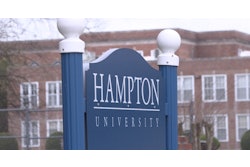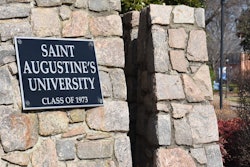A Renewed SpiritAs NAFEO’s new president, Dr. Frederick Humphries vows to make the organization the ‘lead voice’ for all historically black colleges and universities. By Cheryl D. FieldsSILVER SPRING, Md.
So far, the outward signs of change at the National Association for Equal Opportunity in Higher Education (NAFEO) are modest: a newly redesigned Web site, increased attendance at the annual conference and an increased percentage of members whose dues are current. Closer examination, however, exposes more profound change. In less than six months, the organization’s new president, Dr. Frederick S. Humphries, has led the group to raise $500,000 in corporate partnerships, boost paid memberships to nearly 70 percent (up from roughly 40 percent a year ago), draft a new legislative agenda, and refocus its programming agenda to attract participation from a wider array of HBCU administrators.
Both the NAFEO Presidential Summit, which will take place in August in Palm Beach, Fla., and the annual conference, which is planned for next April, are being reorganized to draw administrators at the vice president, provost and dean levels. Humphries also has ordered a reorganization of NAFEO’s leadership awards banquet, which traditionally culminates the annual meeting. The event is being retooled to become a fund-raising opportunity. In addition, Humphries has led the group to settle a long-standing dispute between NAFEO and the United Negro College Fund, by agreeing that UNCF member-institutions will no longer be included in any of NAFEO’s fund-raising activities.
While rectifying problems within the organization and improving its financial status have been on top of Humphries’ list of priorities, he is advocating for even loftier long-term goals, such as the creation of more doctoral programs at historically Black colleges and universities and the creation of additional medical and law schools at HBCUs.
Changes such as these mark the beginning of a refreshing new era for an organization that, as recently as a year ago, appeared critically imperiled. Of course, there are still problems: The organization’s Web site, for example, while redesigned still contains incomplete and erroneous information; the semi-automated phone system continues to frustrate outside callers; and visitors to the organization’s executive suite will notice obvious pockets of unoccupied office space. Nonetheless, there is a renewed spirit at the organization that cannot be ignored.
“I think there has been a new burst of energy that Dr. Humphries brings to everything he does,” says Dr. Larry Earvin, president of Huston-Tillotson College, a NAFEO member. Earvin especially welcomes Humphries’ plans to involve more administrators in the organization’s activities. “It has been needed for a while. … Presidents can’t do everything.”
United Negro College Fund President William H. Gray, who a year ago was perceived as hostile toward NAFEO, now says the rift between the two groups is over and UNCF intends to work cooperatively with Humphries and NAFEO on projects that can benefit both organizations. Black Issues Editor-at-Large Cheryl D. Fields recently caught up with Humphries at NAFEO’s Silver Spring, Md., headquarters. His vision is to empower the organization to fulfill its mandate as an advocate on Capitol Hill for historically Black colleges, while also cultivating African American talent to assume more leadership roles in higher education. These and other thoughts are shared in the following excerpts from the interview.BI: What has changed at NAFEO since your arrival?FH: The thing that we’ve done that I think will be absolutely magnificent for the colleges as we go forward is that we are restructuring NAFEO. Before, NAFEO really just focused on the presidents of the colleges. What we have done since I’ve been here is to begin the development of the broader base of involvement in NAFEO other than the presidents. So, we are forming five institutes and two councils: The Institute for Vice Presidents of Academic Affairs, the Institute for Vice Presidents/Directors of Sponsored programs (research), the Institute for Vice Presidents of Student Affairs, an Institute on Institutional Advancement — which is private-sector fund raising — and the Institute of Title III Coordinators. In addition, teacher education is getting a lot of attention these days.
BI: Since there is such a demand for teachers, I can understand why. And that is a core strength of many NAFEO member-institutions, right?FH: Yes. So, we’re going to have a council of deans of education and a council of deans of arts and sciences since they relate so closely with teacher education. Each institute will probably have a chair and a secretary, a treasurer and the like. Each will be assigned a president because it is still a presidential association. BI: The idea to create these councils and institutes, is that something that emanated from the board?FH: No, that was from me. Those are my thoughts about how to make this organization more relevant.BI: In fact, one of the criticisms that some people have had over the last several years is that the organization had become less relevant and that only a handful of institutions, the stronger and larger ones, have benefited from what the organization offers.FH: I can tell you that the vice presidents and deans are delighted. They have been nothing but positive about this (new) organizational format and their involvement.
BI: How is the financial status of the organization?FH: We’re solvent. We’ve also been busy raising money. We’ve done well. Maybe not as much as I would have liked, but we’ve done OK. We’ve set up corporate partnerships and there is an annual fee to be a partner of $25,000. We’re at the half-million-dollar level, and we think between the corporate partners and the corporate sponsorships we’ll be clear.BI: Are there new corporations that are involved or are these old corporate partners?FH: There are some that are old, but many are new. We have a design that we’ve worked out for the corporate partner. Beyond getting an opportunity to do business with the colleges, we’re going to structure two dialogues per year wherein we bring companies together with (a representative group of) the presidents. BI: I imagine it will also provide opportunities for some HBCUs that haven’t had a chance to work with corporations as well.FH: Right. So, it is a win win for everybody. Out of the deal will come business, some jobs for the graduates for the institutions, some faculty internships, and hopefully, as they build these partnerships and relationships, some philanthropy to the institutions. That is going well, and we think that by the end of the year if we keep doing as well as we’ve done thus far, we should be able to raise $1 million by Dec. 31.BI: How are you doing with membership dues?FH: Right now, of the total membership, we are lurking around slightly in excess of 70 percent. We’ve collected more in membership dues than we’ve ever collected. But that was hard work. I had to go out and meet with some of the presidents and hear their concerns.BI: Did the idea that there will be a new agenda giving their institutions more opportunities to benefit from their affiliation with NAFEO make a difference in their willingness to pay their dues?FH: Oh, yes. I talked about what we were trying to do with the institutes and the like. But we’ve also, since I’ve been here, beefed up the advocacy. Because we were doing rather well in raising resources, we’ve added to the government relations staff and that has made a whole lot of difference in terms of meeting the demand of doing good advocacy. We have a new legislative agenda and there are some fantastic things in there that we are advocating for the colleges.
BI: Will legislative advocacy continue to be a part of NAFEO and do you intend for this function to grow?FH: It will be a critical part. We’re going to be the lead voice for HBCUs, public, private, rural and two-year. We’re going to put the resources there to make sure that we are the voice for Black colleges. Not only the historically Black colleges, but the predominantly Black institutions as well. BI: Can NAFEO also become an advocate for Black students at traditionally White institutions?FH: We have always been an organization that worried about the welfare of Black higher education, period. Our primary interest was Black colleges, but we always worried about Black higher education: the production of Blacks and the opportunity. I mean when we talk about Ph.D. production we’re not talking about Ph.D. production from Black colleges. When we talk about how graduate schools ain’t getting the job done, we’re not just talking about graduate schools at Black colleges, we’re talking about graduate schools in America and the stuff that goes on to prevent us from getting our parity representation. BI: Are there opportunities then for NAFEO institutions to partner with other large research institutions, comparable to some of the partnerships you worked out at Florida A&M?FH: We are going to do that. We will probably do it from an association basis. When I get time, my plans are to sit down with Peter Magrath (president) from the National Association of State Universities and Land-Grant Colleges (NASULGC) and Nils Hasselmo (president) at the Association of American Universities to strategize with them to work out this problem to get more Blacks to get Ph.D.s in America.
BI: How hard is it to convince mainstream institutions that what is in the interest of HBCUs is also in their long-term institutional best interests? FH: I think part of the difficulty is getting a clear articulation of a vision that everybody can buy into and then getting somebody to be in charge who is dedicated to getting it done. BI: The agenda you’ve laid out for NAFEO is very ambitious. I could see someone pursuing that for another 10-15 years, but I don’t see you planning to be at NAFEO that long. What are you hoping you can leave with NAFEO?FH: My goal is that I will have been a part, along with the other people who are going to be working around here, in creating a very strong, outstanding organization that is viewed as a terrific place to work and a terrific organization that represents Black colleges. And that we have helped to make the case of the continued preciousness of our institutions. Hopefully, that will happen within about five years. Down the road, I think NAFEO is going to need younger talent that is on a mission, that has got to make their reputation by continuing the work here. I’m certainly not intending to stay around for 10 years. BI: When we look at your decision to come here and Johnnetta Cole’s decision to go to Bennett College … you all have already made your big marks. Neither of you need to do this. Yet, you’ve taken on these ailing institutions. I wonder do you see that same passion and dedication among the generations that are following you?FH: Well, you see that is why (at NAFEO) we’ve got to have this broadening. We’ve got to get more people into the cauldron where they see the passion and the dedication of people. I think we’ll build a better spirit. And out of that will come our new leaders with commitment and passion for the work we’ve got to do ahead.
© Copyright 2005 by DiverseEducation.com















